Total solar eclipse 2024: Watch video and see photos of the sky spectacle
EAGLE PASS, Texas ? In a moment of cosmic alignment that was precisely predicted yet undeniably mysterious, the moon crept across the face of the sun as seen from Earth, casting its shadow onto the United States on Monday.
And then it was over: A total eclipse of the sun has come and gone.
The partial shadow crossed into the U.S. in Texas just after noon local time, and a bit more than an hour later, the minutes of “totality” began. The total eclipse of the sun then traced a path from southern Texas to northern Maine, where it exited into Canada and the ocean beyond.
The rare event was an astronomical experience like no other. Monday's eclipse was unusually accessible to millions of people. It was widely anticipated not only for its remarkable period of darkness, but for its rare timing: No total solar eclipse would be visible from the contiguous United States again until 2044. While millions of Americans may have seen today’s eclipse, a small group in Texas was among the very first.
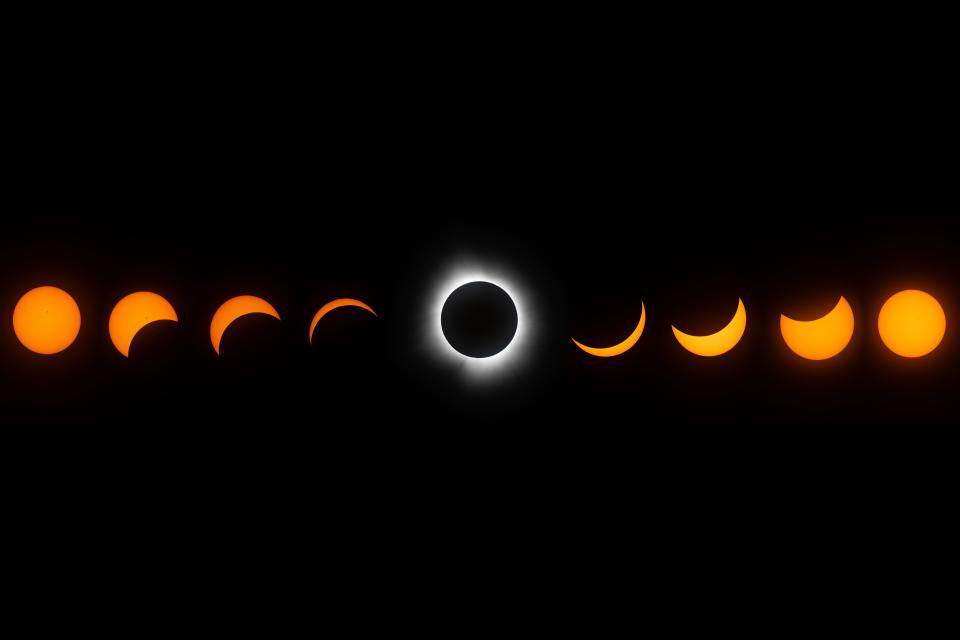
Edge of eclipse shadow began in south Texas
Alejandra Martinez, a seventh-grade science teacher from the south Texas border city of Eagle Pass, peered up at the gray, gauzy sky, anxiously awaiting the solar eclipse’s entrance into the USA.
Sitting with a telescope under a camping canopy in a corner of the county airport, Martinez, 42, and two other science enthusiasts had been recruited by NASA to participate in an effort called Citizen CATE 2024, where more than 30 teams perched in the eclipse’s path will record the shadowy trek across the country.
In this spot, less than five miles from the U.S.-Mexico border, she and her team would be among the first people in the U.S. to witness the phenomenon. Eagle Pass sits near the very beginning of the eclipse’s track from southwest to northeast across the country. It also sits very near dead-center of it, where the period of “totality” will be the longest. That total shadow was still more than an hour away when the edge of the shadow began to darken the sky.
Martinez, dressed in a “This Totality Rocks” T-shirt and eclipse-themed skirt, watched as the penumbra crept across the airfield, about 10 minutes past noon local time. She put on her eclipse glasses and peered up at the sky. The gauzy clouds parted. “There it is! There it is!” she yelled. “First contact. It’s begun!”
Clouds came and went as the shadow grew for the next hour. As totality approached Eagle Pass, the sky shaded a dull gray then a heavy brown and the temperature dropped a few degrees. Only a sliver of the sun remained.
A few seconds before 1:27 p.m. CT, the crowd counted down, “3..2..1…” The sun was gone, completely covered by the moon. Darkness spread over the small airport grounds. “Oh my god,” Martinez said, a hand covering her heart. “This is so cool!”
How to tell if you have eye damage from looking at a partial eclipse?
For those who took a chance and looked at the sun without protective eyewear during the eclipse, concerns may arise if their vision starts to seem impaired. Have they suffered eclipse blindness?
Looking directly at the sun even briefly without the proper safety glasses can result in eye damage, either temporary or permanent. The body's natural squinting reaction in normal circumstances prevents people from staring directly at the sun, but that reflex may not be activated during partial eclipses, even though a partly shielded sun can still burn the retina.
The American Academy of Ophthalmology says pain won't be an indication of damaged eyes because the retina lacks pain nerves. Worrisome signs are instead blurry vision, headaches, light sensitivity, blind spots in the central vision, distorted vision and changes in color perception. Anyone experiencing those symptoms should see an ophthalmologist, the AAO says.
What was the timeline of the 2024 solar eclipse?
The total eclipse began in Mexico at about 11:07 a.m. PDT, Monday before crossing into Texas at 1:27 p.m. CDT. It ended in Maine at 3:35 p.m. EDT. Even those who weren't in the path of totality could see a percentage of the eclipse.
To find out exactly when the eclipse occurred in your area, you can search by USA TODAY's database by ZIP code for a viewing guide.
Students in Washington get hands-on learning
Dozens of students spilled out of Ida B. Wells Middle School in Washington, D.C., gripping cardboard solar eclipse glasses and chatting with excitement. “Why is the sun shaped as a moon?” one student asked after looking toward the sun. “Why is it not getting dark?’’ asked another.
Teacher Troy Mangum, who the students called “Mr. Mango,’’ slowly explained the science behind the experience as he cautioned others to put on their glasses. Students at the school in northwest D.C. had had lessons about the eclipse leading up the day’s teaching outside the classroom.
“Anytime we can get hands on or dynamic learning … it’s invaluable,’’ said Mangum, a social emotional learning coach. “We talked about it so much. It’s nice to see them get excited about qeeky Mr. Mango type of stuff.”
Skylar Cruel, 12, had come outside with her science class. “I just really wanted to see it,’’ she said. “You get to see it turn from light to dark.”
Steps away at Whittier Elementary School, which focuses on science, technology, engineering and math (STEM), younger students put on their glasses and tilted their heads up toward the sun behind their school.
Michael Haile joined his daughter, Markan Worku, 9, a student at Whittier, and brought along his 5-year-old son, Keab. He called it a memorable experience for his children. Markan, who had been learning about solar eclipses in her third-grade class, simply said, “This is cool!’’
? Deborah Berry
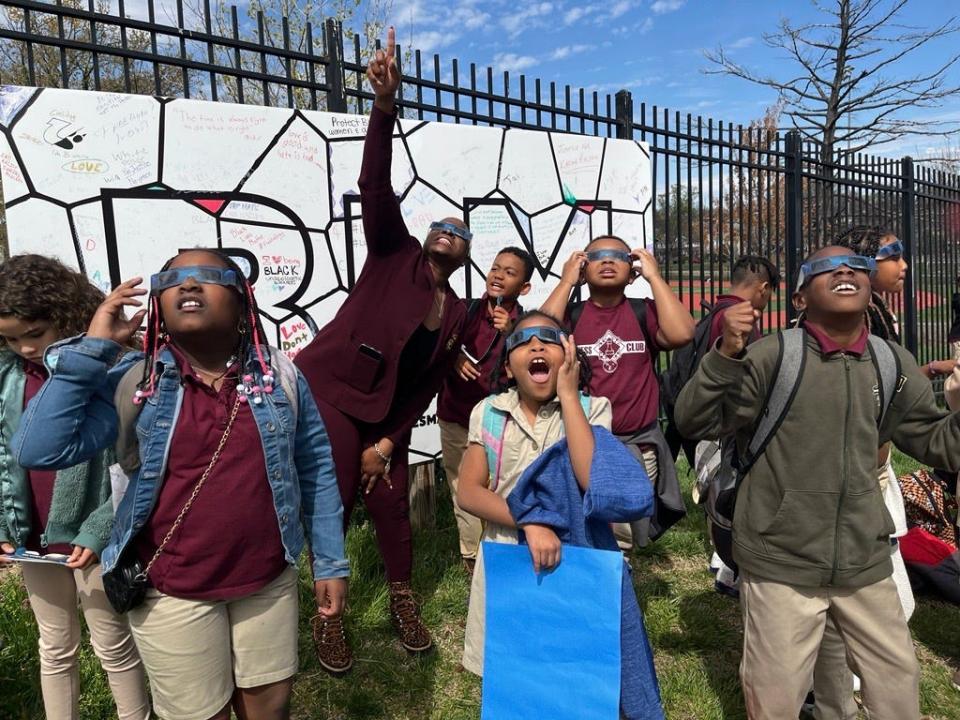
In Michigan, a bonding experience for a mother and her three kids
In Michigan, eclipse enthusiasts packed a watch party along the Detroit Riverwalk near Cullen Plaza. They sat on the grass, on benches and berms. For Janelle Ikonen of Waterford, it was a chance to bond with her three children ? Hannah, 9; Elim, 12; and Isaac, 14 ? whom she took out of school for the day.
“I wanted to experience a unique event with them,” said Ikonen, 47. “It’s one of my big deals to me, to experience things with my kids. … I hope they’ll remember spending time with me.”
In Grand Rapids, where 94% coverage of the sun was expected, viewers gathered on the city's “Blue Bridge,” which offered a view of the eclipse over the Grand River. With no cloud cover over the city, visitors had an unobstructed scene. The Grand Rapids Public Museum set up a series of solar telescopes.
Jill and Wes Johnson, 50 and 14, were among those awaiting max coverage. They’d considered traveling from Grand Rapids to a place with total coverage, but decided 94% coverage was worthwhile enough to stay home.
“I think people are excited to see something unique,” Jill Johnson said.
? Georgea Kovanis and Arpan Lobo, Detroit Free Press
US women's soccer team takes in eclipse ahead of title game
COLUMBUS, Ohio ? The U.S. women’s national soccer team took a break from SheBelieves Cup preparation to watch the eclipse.
Several team members, including World Cup veterans Crystal Dunn, Alyssa Naeher, Naomi Girma and Trinity Rodman, coaches and staff members donned eclipse glasses and went outside their hotel to see the rare event.
As the sky darkened and the moon moved in front of the sun, someone yelled, “Come on, keep going!” Columbus is just outside the path of totality, so all but a sliver of the sun wound up being covered.
The USWNT is in Columbus for the final of the SheBelieves Cup on Tuesday night against Canada.
? Nancy Armour
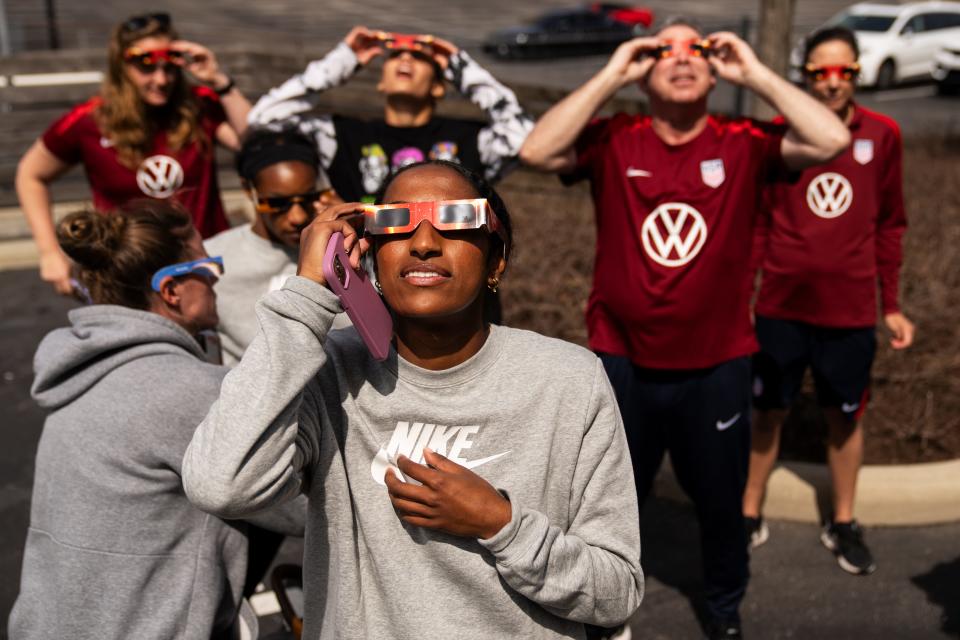
Witnessing the first total eclipse from a cruise ship
Passengers aboard Holland America's Koningsdam cruise ship eagerly gathered on the top decks at 10 a.m. local time to watch the spectacle of a solar eclipse.
Positioned off the coast of Mazatlan, Mexico ? the first city in North America to witness the total eclipse ? the ship provided an ideal vantage point for viewing the celestial event. Accompanied by an astronomer, the captain meticulously adjusted the ship's position to ensure the best possible view.
Dan Fueller, an experienced eclipse observer who had previously seen similar phenomena from ships in 1991 and 1998, emphasized the advantages of viewing the eclipse from a cruise ship. He noted the flexibility of the ship's mobility allowed for optimal positioning along the eclipse's path, ensuring unobstructed views.
"You're on a cruise ship and (the best view) is a little bit farther to the west or a little bit farther to the east ? along the path, there's a clear sky ? the ship can move. If you're on land and there's not a road there, you better have a tank."
? Joshuan Rivera
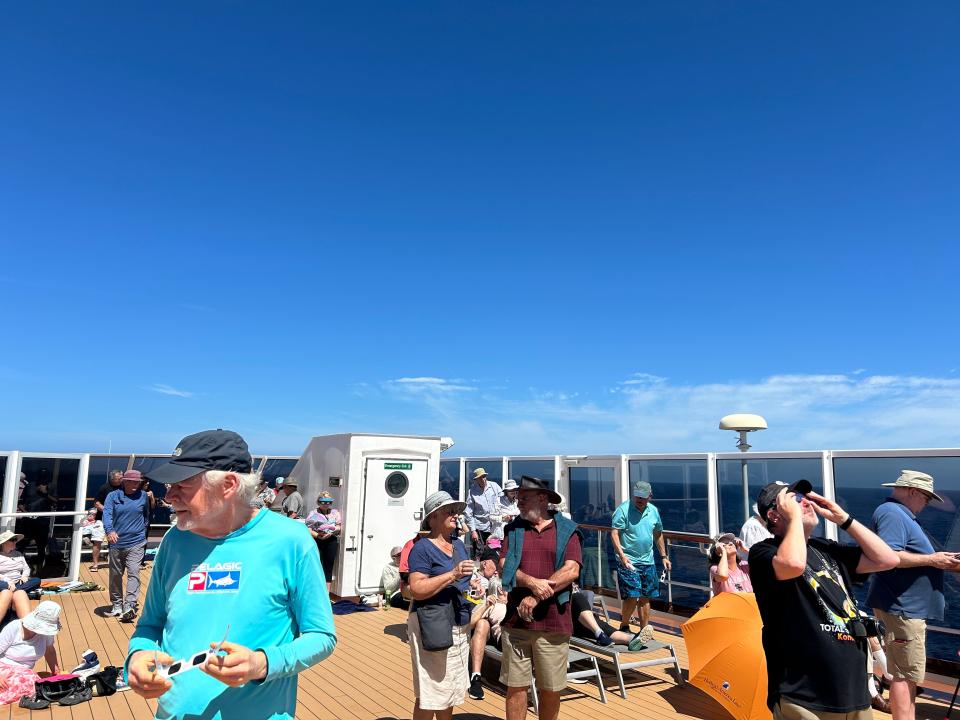
Partial eclipse 'like a little Pac-Man taking a bite out of the sun'
In Parthenon, Arkansas, the eclipse began near the Buffalo National River. Five friends traveled from Florida to be on a rock outcropping to witness the celestial event.
“Yes! I see it!” Angie Printiss exclaimed.
“Oh ya! You can see it,” said Kate Estes. “It’s like a little Pac-Man taking a bite out of the sun.”
At 20 minutes before totality, the sky got noticeably darker. The shadow of crescent sun shapes played off the limestone rocks.
“It looks like water ? like fish scales,” Estes said. “That is so weird, when the trees move you can really see it.”
? Jennifer Portman
New Englanders travel for better view of the eclipse
Crowds ballooned into the thousands midday Monday in the center of St. Johnsbury, Vermont, as the nearly cloudless sky and warm sun boosted temperatures to an unseasonably 60 degrees.
Jim and Kim Cooper drove over from New Hampton, New Hampshire, their first time doing more than just passing through the town locals call St. Jays. Their son had proposed to his girlfriend in Tennessee during the 2017 eclipse and then had an eclipse-themed wedding, but the Coopers had never seen a total eclipse for themselves, so they decided to come to the closest place where they could be assured of a good view.
Jeffrey Breau had seen that 2017 eclipse for himself and was so impressed that he convinced family members to join him this time. Breau’s girlfriend, Nell Hawley, came up with him from Cambridge, Massachusetts, while his brother Alex and his girlfriend Diana Ventura drove up from New York City. The Breau brothers' father, Walter, joined them in taking in their first eclipse.
“I would have been OK watching it in the yard,” Walter said, though he would only have seen a partial eclipse from there. “That’s what you think now,” Jeffrey said quickly. “Talk to me in two hours.”
? Karen Weintraub
Kids bring homemade eclipse viewers to National Mall
Lucas and Lucy Porto Banco didn’t need to buy fancy eclipse glasses – the 7- and 10-year-old siblings made their own eclipse viewers from two cardboard shoe boxes left over from a couple of their mom’s recent shoe purchases.With the help of a YouTube tutorial video, they made two holes in each box with a whittling knife and taped tin foil over. Then they used dry spaghetti to poke holes in the tin foil for the sun’s light to pass through and project onto the dark inside of the box.The kids put together the viewer in little more than five minutes, Lucy said. “Maybe 15, with covering all the gaps in the shoe box,” she said.Even with his own eclipse-viewing creation, Lucas said he may still take advantage of his eclipse glasses. “I’m going to do both,” he said.
? Cybele Mayes-Osterman
What is an 'umbra?' ? and other eclipse words
Astronomers and eclipse enthusiasts used a bunch of specialized words Monday as the nation experienced its first solar eclipse since 2017 and the last one for until 2044. Here are a few of those terms and what they mean, according to the American Astronomical Society.
Baily's Beads – This refers to the beaded appearance of the moon's edge as the eclipse nears totality. Shafts of sunlight shine through deep valleys on the moon's surface, which causes the effect known to observers as Bailey's Beads.
Umbra – The darkest part of the moon’s shadow, within which the entirety of the sun's bright face is blocked. An observer standing in the umbra sees a total solar eclipse.
Penumbra: The lighter part of the moon's shadow, making up its outer portion, where light can reach.
Corona – The sun’s upper atmosphere, visible as a pearly glow around the eclipsed sun during totality.
Totality – The maximum phase of a total solar eclipse, during which the moon’s disk completely covers the sun's bright face. It can last from a fraction of a second to a maximum of 7 minutes, 31 seconds, depending on viewing location and other factors.
? Dale Denwalt, The Oklahoman
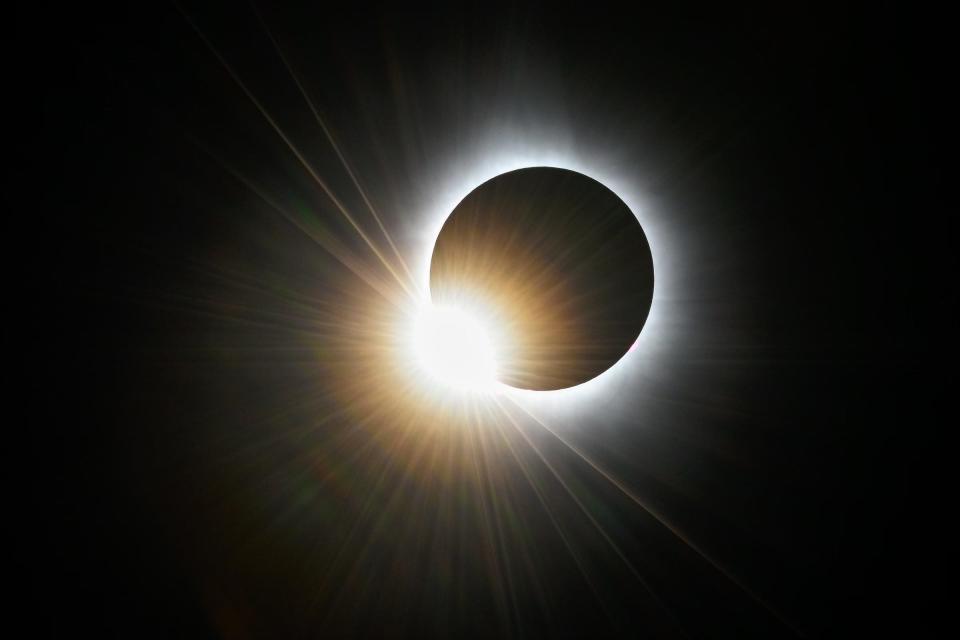
A last-minute search for glasses for 'a perfect spot'
Patsy Faoro walked toward a half dozen people gathered at the gate of Turner Farm Park in Great Falls, Virginia. The people were awaiting the opening of an eclipse viewing event complete with telescopes and educational presentations.
Faoro, who lives near the park in this upscale Northern Virginia neighborhood, just wanted glasses to safely view the eclipse.
She visited CVS, Safeway and a 7/11 convenience store, all of which had advertised the availability of glasses to view the eclipse. None of the retailers had any glasses remaining when Faoro checked this morning.
“We have this great big open space that’s a perfect spot,” said Faoro, who viewed her first eclipse in the 1970s. “We just need some glasses.”
? Ken Alltucker
Indianapolis Motor Speedway event draws tens of thousands
Tory Patrick, 41, is hoping to give her four children a once-in-a-lifetime learning opportunity. Patrick and her family traveled 160 miles to Indianapolis Motor Speedway from their home in Granger, Indiana. They were expected to have 97% totality at home, but it’s not the same as total coverage, she said.
“They will be getting the full experience that they can’t read about in textbooks,” Patrick said.
Patrick and her sister Cally Gannon, 39, from Cincinnati, met in Indianapolis to view the eclipse from the speedway. They camped outside IMS over the weekend ahead of the event and on Sunday afternoon saw a double rainbow over the speedway’s iconic pagoda. An estimated 50,000 tickets were sold for the day’s festivities, presented in partnership with NASA and Purdue University.
Elsewhere in the stands, Ryan Harper, 30, knows today is special.
“We’re right in totality,” he said. “This sometimes doesn’t happen in people’s lifetimes.
— Sarah Bowman and Jade Thomas
Family travels from Baltimore to Rochester, N.Y., to view the eclipse
When Maze Pelham of Baltimore was a fifth-grader, he watched news of the 2017 solar eclipse and vowed to witness the next notable solar eclipse. That eclipse, and that day, has come. And this is why he and his parents, Janice and Sonney Pelham, left Maryland around 1 a.m. on Monday and drove nearly seven hours to Rochester, New York.
“I said to myself I would go to the next one,” Maze Pelham said while seated with his parents on lawn chairs at downtown Rochester’s Parcel 5 park, where he and hundreds of others are awaiting a view of the full eclipse. “It’s a promise I made to myself.”
– Democrat and Chronicle, part of the USA TODAY Network
In Brooklyn: Eclipses glasses, check. Lawn chair, check.
Ralph Emerson held a pair of paper sunglasses in his hands while riding the subway to Brooklyn's sprawling Prospect Park on Monday. He exited the train with a folded lawn chair strapped across his shoulder, and said he felt energized and full of anticipation.
"This is special," Emerson, 61, said. "I haven't woken up with this much excitement since the Super Bowl."
Walking to the park's botanic garden, Emerson said appreciating natural phenomena makes it easier to manage the stresses that come with living in a big city. Also like a big sports game, the eclipse will draw lots of people together to experience something much larger than themselves, in community, he said.
"A lot of times it's tragedies that bring us together, but sometimes things like this do," he said.
? Claire Thornton
Texas Eclipse Festival cut short by weather
The Texas Eclipse Festival was canceled Monday in Burnet County, 50 miles northwest of Austin, because of weather concerns. The festival, which included bands and other events, began Sunday and was supposed to wrap up Tuesday.
"We regret to inform you of the severe weather forecast, including risks of high winds, tornadic activity, large hail, and thunderstorms for later today, including during the eclipse, Tuesday, and Wednesday," festival organizers said on their website. "Your safety is our top priority."
Festivalgoers were urged to leave early for safety and to beat traffic. Guests, however, were allowed to stay "provided they pack and are prepared to depart after totality."
Traffic jams, collisions mar eclipse watchers' travel
Traffic crashes and road delays were reported across the nation as Americans flocked to prime locations to gaze up at the rare solar eclipse. Local roads and highways in states including Texas, Ohio, Illinois, Indiana, Vermont and New Hampshire were overwhelmed with eclipse chasers, many of whom were from out of state. The most intense bottlenecks appeared to be in the path of totality, where spectators will be able to view the full eclipse.
In Oklahoma, a crash around 7:30 a.m. local time narrowed eastbound lanes on I-40, a major transcontinental highway that runs from California to North Carolina. The crash occurred not far from several state parks that were hosting eclipse events, and it's also within driving distance of the full eclipse path, which includes parts of southeastern Oklahoma and Arkansas.
Multiple crashes were reported on an interstate in Waco, Texas, a city in the path of totality, where several festivities and eclipse viewing events were scheduled. The crashes all occurred on I-35, which runs from southern Texas to Minnesota.
"Expect major traffic delays in this area," the Texas Department of Transportation said in a statement.
? Christopher Cann
Airport draws a crowd of jets for eclipse
EAGLE PASS, Texas ? Maverick County International Airport in Eagle Pass, Texas, usually sees maybe three private planes a day. By 10 a.m. CT on Monday, more than 10 planes crowded the tarmac, including Cessnas, Pipers and at least one corporate jet ? all there to catch an early glimpse of the total solar eclipse. Eagle Pass will be one of the first American cities to witness the phenomenon. Some watchers, like Brandon Beck, 43, flew in Sunday night from San Diego and spent the night in a sleeping bag on the tarmac next to his friend’s Mooney single-prop piston four-seater.“We’re so lucky to be on a planet where the sun is the perfect size and perfect distance to create that effect,” he said. “It’s obligatory. We have to see it.”
First the Cherry Blossoms, then the eclipse
WASHINGTON ? The Cherry Blossoms brought Ali and Aurore Youssouf to the city all the way from Paris, but the pair were delighted to learn that their trip would overlap with the eclipse. The day is extra special for Aurore Youssouf, 43, who has never seen an eclipse before. On Monday morning, the couple arrived by chance at the National Mall early enough to snag a few pairs of free eclipse glasses distributed by the Smithsonian National Air and Space Museum for the occasion.“We didn’t even know. We just ended up here and found out that they were giving away some glasses,” said Ali Youssouf, 46.
? Cybele Mayes-Osterman
Awaiting eclipse ? and hail ? in Texas
KERRVILLE, Texas ? Forecasts called for considerable cloudiness, rain and possible hail, but retired NASA engineer Jeff Stone stayed positive as he and his wife prepared to host more than a dozen people for a watch party at their hilltop home in Texas Hill Country. Stone, an eclipse enthusiast who had met family in Missouri to watch the solar eclipse of 2017, said he recently reviewed video footage of that event and said current conditions weren’t that much different than they were back then.
“I’m outside and seeing patches of blue among scattered clouds, so we’re remaining hopeful,” he said.
About 150 miles to the northeast in Gatesville, lead pastor Eric Moffett of Coryell Community Church said a similar forecast did little to deter an expected gathering of about 800 visitors for the church’s family-oriented “Eclipse at the Crosses” event. Many, if not most, were from out of town or even out of country ? Canada, Wales, France, Italy. Many locals were staying home to avoid the crowd, he said.
“It’s partly cloudy, but the sun is shining on me right now,” he said. “We are praying that it stays that way.”
? Marc Ramirez
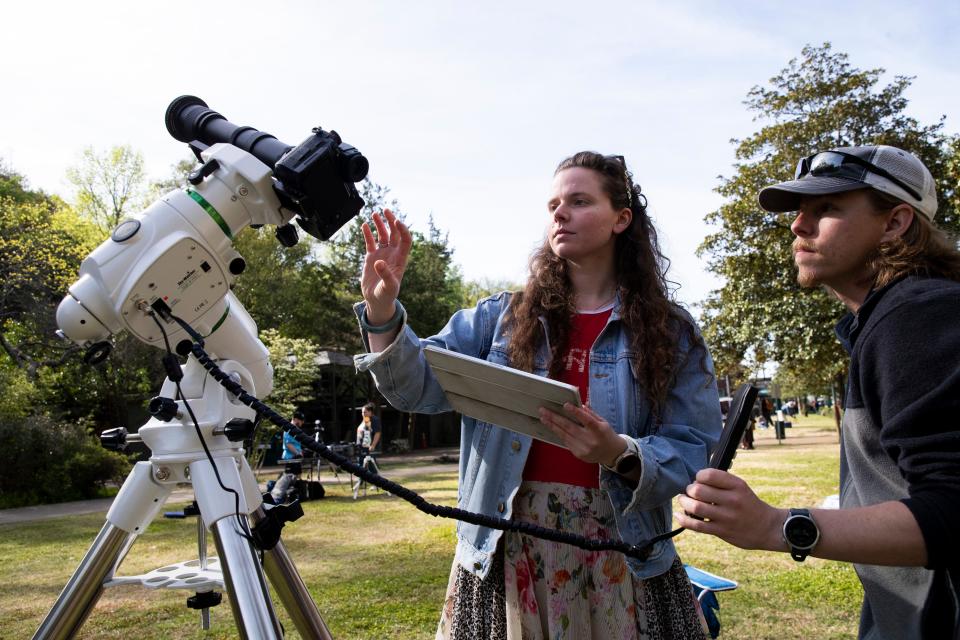
What is the difference between a solar eclipse and a lunar eclipse?
A total solar eclipse occurs when the moon comes in between the Earth and the sun, blocking its light from reaching our planet, leading to a period of darkness lasting several minutes. A total lunar eclipse occurs when the moon and the sun are on exact opposite sides of Earth. The Earth blocks the sunlight that normally reaches the moon. Instead of that sunlight hitting the moon’s surface, Earth's shadow falls on it.
A lunar eclipse can last for a few hours, while a solar eclipse lasts only a few minutes. Solar eclipses also rarely occur, while lunar eclipses are comparatively more frequent. While at least two partial lunar eclipses happen every year, total lunar eclipses are still rare, NASA says. Another major difference: No special glasses or gizmos are needed to view the a lunar eclipse, and people can directly stare at the moon.
? Saman Shafiq
Solar eclipse, lunar eclipse: What is the difference?
Can you drive during the solar eclipse?
The 2024 solar eclipse will shroud much of the United States in darkness on Monday, leaving many people to wonder: Is it safe to drive during the solar eclipse?
It is safe to drive during an eclipse as long as you don't look up at the sky. AAA is telling drivers to be focused on the road if they are operating a car during the total solar eclipse. But the automobile insurance company is advising Americans who want to safely view the total eclipse to "find a safe place to park (not on the side of a road or highway) away from other traffic and then wear your eclipse glasses," said Aixa Diaz, a spokeswoman from AAA.
"Pack your patience, whether traveling a great distance or locally," Diaz said. "People will be out and about to catch a glimpse of the eclipse."
A similar scenario played out in 2017 during the nation's last total solar eclipse: Congestion in some areas lasted for up to 13 hours after totality, according to Transportation Research News, a National Research Council publication. An analysis of traffic patterns from that year suggests the worst of the traffic – on interstates and rural back roads alike – will kick off after the eclipse ends and everyone tries to leave all at once.
? Kayla Jimenez
When will the next solar eclipse happen?
It will be 20 years before there's a chance to witness a total solar eclipse in the United States again. According to NASA, after Monday's total solar eclipse, the next one viewable from the contiguous U.S. will be on Aug. 23, 2044.
Unfortunately, the 2044 total solar eclipse won't have the broad reach across the U.S. as the 2024 eclipse. The path of totality during the 2044 eclipse will only touch three states, according to the Planetary Society, a nonprofit involved in research, public outreach and political space advocacy. The eclipse will begin in Greenland, sweep through Canada and end around sunset in Montana, North Dakota and South Dakota.
But another eclipse scheduledfor Saturday, Aug. 12, 2045, will trace a path of totality over California, Nevada, Utah, Colorado, New Mexico, Oklahoma, Kansas, Texas, Arkansas, Missouri, Mississippi, Louisiana, Alabama, Florida and Georgia.
? Mary Walrath-Holdridge, Gabe Hauari and Eric Lagatta
Eclipse and pets: It's not the sky that's the problem
An eclipse itself isn't dangerous for domestic animals such as dogs and cats, but experts say it's probably best to not bring pets to experience the April 2024 total solar eclipse. Experts' biggest concern is not what’s happening in the sky but on the ground as crowds of excited and eager people gather, said Dr. Rena Carlson, president of the American Veterinary Medical Association. Dogs especially will take their cues from their owners rather than the celestial event.
“Rather than the effects of the eclipse, I would be more worried about the excitement and all of the people,” Carlson said.
? Elizabeth Weise
Happy #EclipseDay2024! ??
Follow along today with GOES-East here: https://t.co/7RRd4xnsyi pic.twitter.com/xBc799GEfO— NWS Weather Prediction Center (@NWSWPC) April 8, 2024
A guide to the solar eclipse for kids
Here's an easy-to read, illustrated guide to help kids understand what the April 8 total solar eclipse means, where it will be visible and how you can watch it safely. It also shows them how an ordinary kitchen colander can easily be used to view a solar eclipse ? the colander's holes can project crescent images of the sun onto the ground. There are even pages that can be downloaded and colored.
An eclipse is worth marveling at.
But don't be silly, folks – play it safe and wear protective eyewear. pic.twitter.com/S6REAiZ735— President Biden (@POTUS) April 8, 2024
Trump's eclipse experience lit up internet in 2017
Seven years ago, when the last total solar eclipse crossed over North America, a photo of then-President Donald Trump seemingly gazing at the sun with his naked eyes set the internet ablaze. During the afternoon of Aug. 21, 2017, Trump, who was president at the time, was joined by then first lady Melania Trump and their son Barron to watch the rare phenomenon from the Truman Balcony at the White House. Photos taken by members of the media captured all three donning eclipse glasses while looking at the eclipse.
But at one point during the viewing, the former president was captured in photos and videos without proper eye protection, seemingly gazing directly at the sun. Looking at an eclipse before or after the brief phase of totality without proper eyewear can lead to eye damage.
? Natalie Neysa Alund
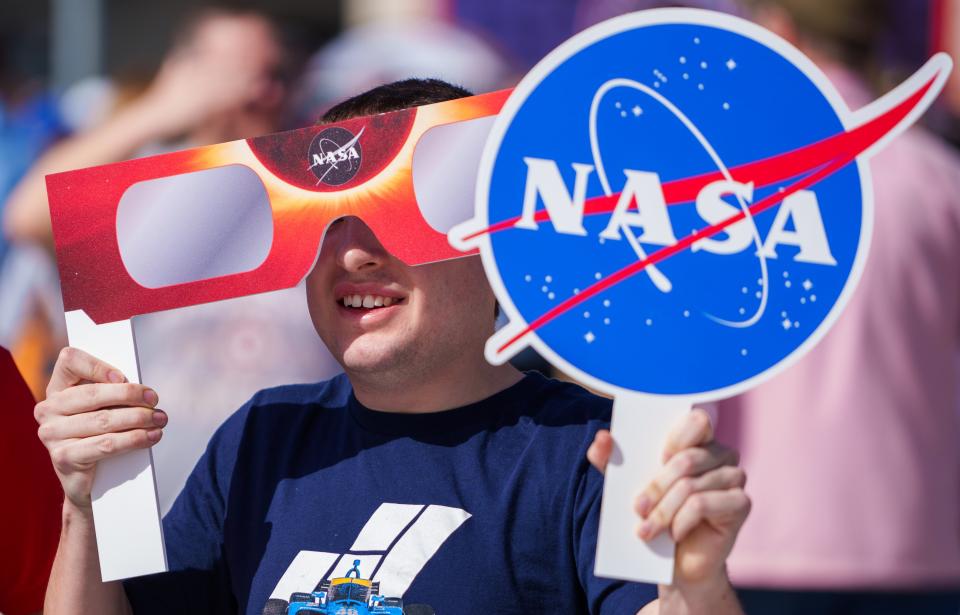
When is the next total solar eclipse? What to know about the next eclipse's path, timing
How to make a solar eclipse viewer
People who didn't manage to get their hands on glasses are not completely down and out. There are other safe ways to view the eclipse, say experts, and a lot of them only require a little bit of craftiness and items you can find lying around the house.
Steps to make the cereal box eclipse viewer (And here is a video aid):
Get an empty, clean cereal box.
Cut a white piece of cardboard that will fit snuggly in the bottom of the box, or secure it permanently by gluing it in place.
Cut the top of the cereal box, removing both ends and leaving the center intact.
Put a piece of tape across the center of the top to securely hold it closed.
Tape a piece of heavy-duty foil or double a single layer for additional strength, covering one of the openings at the top of the cereal box. The other opening will remain open for viewing.
Using a small nail (approximately 3mm in diameter) push a hole in the foil.
Cover the entire box with construction paper, leaving the single-viewing opening and the foil uncovered.
The finished box should be held with the pin-hole side facing the sun. It may take a little practice pointing the box. With your back facing the sun, look through the viewing opening. A small image of the sun, about ? cm in diameter, can be seen projected on the white paper inside the box.
? Mary Walrath-Holdrid
What is the path of the solar eclipse called?
Those in the direct line of the eclipse will be treated to an incredible sight as the moon completely blots out the sun's disk, ushering in uncharacteristic darkness and revealing the sun's elusive outermost layer called the corona. That moment is called "totality" and this year the path of totality crosses through 13 U.S. states.
The last total solar eclipse to cut through North America was in August 2017.
How to look at eclipse without glasses
A total solar eclipse offers skygazers the rare opportunity to witness the eclipse with the naked eye. However, solar eclipse glasses are still needed until totality is reached.
Certified solar eclipse glasses are crucial for spectators to avoid the sun's retina-damaging rays. But when the moon moves completely in front of the sun and blocks its light, you'll know it's safe to remove the glasses for a short period of time.
How fast does an eclipse shadow travel?
According to a post from the National Weather Service in Indianapolis on X, an eclipse shadow travels at speeds from 1,100 to 5,000 mph. Near the equator, it travels at around 1,100 mph and increases in speed as it approaches the poles.
The eclipse party is over? Time to recycle those glasses!
Astronomers Without Borders, or AWB, a non-profit organization running its second nationwide eclipse glasses recycling drive. Her business will join over 300 schools, museums, city governments, commercial businesses, community organizations and local libraries that will collect and ship an estimated millions of glasses to be repurposed for use by underserved communities around the world in future solar eclipses.
AWB launched its first run of the program after the last solar eclipse in 2017 when volunteer centers across the country collected millions of the glass. After vetting them for reuse, more than half a million glasses were distributed to Africa, Asia and South America.
People can visit AWB's website to find their nearest participating collection center and learn more about recycling the glasses, said Andrew Fazekas, the organization's communication manager.
"We figure there's probably going to be tens of millions of glasses out there at the very least," he said. "And most of them are probably very gently used."
? Cybele Mayes-Osterman
This article originally appeared on USA TODAY: Solar eclipse: See video and photos of the sky spectacle
